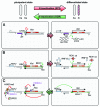Coupling of X-chromosome reactivation with the pluripotent stem cell state
- PMID: 25137047
- PMCID: PMC4179954
- DOI: 10.4161/rna.29779
Coupling of X-chromosome reactivation with the pluripotent stem cell state
Abstract
X-chromosome inactivation (XCI) in female mammals is a dramatic example of epigenetic gene regulation, which entails the silencing of an entire chromosome through a wide range of mechanisms involving noncoding RNAs, chromatin-modifications, and DNA-methylation. While XCI is associated with the differentiated cell state, it is reversed by X-chromosome reactivation (XCR) ex vivo in pluripotent stem cells and in vivo in the early mouse embryo and the germline. Critical in the regulation of XCI vs. XCR is the X-inactivation center, a multigene locus on the X-chromosome harboring several long noncoding RNA genes including, most prominently, Xist and Tsix. These genes, which sit at the top of the XCI hierarchy, are by themselves controlled by pluripotency factors, coupling XCR with the naïve pluripotent stem cell state. In this point-of-view article we review the latest findings regarding this intricate relationship between cell differentiation state and epigenetic control of the X-chromosome. In particular, we discuss the emerging picture of complex multifactorial regulatory mechanisms, ensuring both a fine-tuned and robust X-reactivation process.
Keywords: PRDM14; Tsix; X-chromosome reactivation; Xist; epigenetics; long noncoding RNA; pluripotency; reprogramming; stem cells.
Figures


Similar articles
-
New Insights into X-Chromosome Reactivation during Reprogramming to Pluripotency.Cells. 2020 Dec 17;9(12):2706. doi: 10.3390/cells9122706. Cells. 2020. PMID: 33348832 Free PMC article. Review.
-
Tsix RNA and the germline factor, PRDM14, link X reactivation and stem cell reprogramming.Mol Cell. 2013 Dec 26;52(6):805-18. doi: 10.1016/j.molcel.2013.10.023. Epub 2013 Nov 21. Mol Cell. 2013. PMID: 24268575 Free PMC article.
-
Female human pluripotent stem cells rapidly lose X chromosome inactivation marks and progress to a skewed methylation pattern during culture.Mol Hum Reprod. 2016 Apr;22(4):285-98. doi: 10.1093/molehr/gaw004. Epub 2016 Jan 19. Mol Hum Reprod. 2016. PMID: 26786180
-
Molecular coupling of Tsix regulation and pluripotency.Nature. 2010 Nov 18;468(7322):457-60. doi: 10.1038/nature09496. Nature. 2010. PMID: 21085182
-
X-chromosome epigenetic reprogramming in pluripotent stem cells via noncoding genes.Semin Cell Dev Biol. 2011 Jun;22(4):336-42. doi: 10.1016/j.semcdb.2011.02.025. Epub 2011 Mar 3. Semin Cell Dev Biol. 2011. PMID: 21376830 Free PMC article. Review.
Cited by
-
New Insights into X-Chromosome Reactivation during Reprogramming to Pluripotency.Cells. 2020 Dec 17;9(12):2706. doi: 10.3390/cells9122706. Cells. 2020. PMID: 33348832 Free PMC article. Review.
-
A self-enhanced transport mechanism through long noncoding RNAs for X chromosome inactivation.Sci Rep. 2016 Aug 16;6:31517. doi: 10.1038/srep31517. Sci Rep. 2016. PMID: 27527711 Free PMC article.
-
Pseudoautosomal Region 1 Overdosage Affects the Global Transcriptome in iPSCs From Patients With Klinefelter Syndrome and High-Grade X Chromosome Aneuploidies.Front Cell Dev Biol. 2022 Feb 3;9:801597. doi: 10.3389/fcell.2021.801597. eCollection 2021. Front Cell Dev Biol. 2022. PMID: 35186953 Free PMC article.
-
Chromosome compartments on the inactive X guide TAD formation independently of transcription during X-reactivation.Nat Commun. 2021 Jun 9;12(1):3499. doi: 10.1038/s41467-021-23610-1. Nat Commun. 2021. PMID: 34108480 Free PMC article.
-
PRC2 mediated KLF2 down regulation: a therapeutic and diagnostic axis during tumor progression.Cancer Cell Int. 2023 Oct 8;23(1):233. doi: 10.1186/s12935-023-03086-3. Cancer Cell Int. 2023. PMID: 37807067 Free PMC article. Review.
References
Publication types
MeSH terms
Substances
Grants and funding
LinkOut - more resources
Full Text Sources
Other Literature Sources
